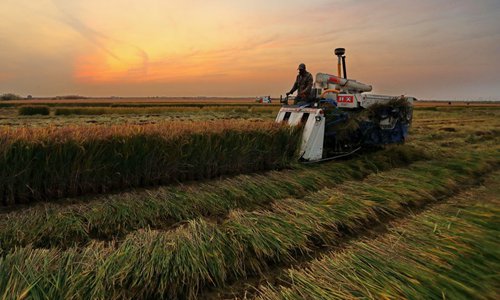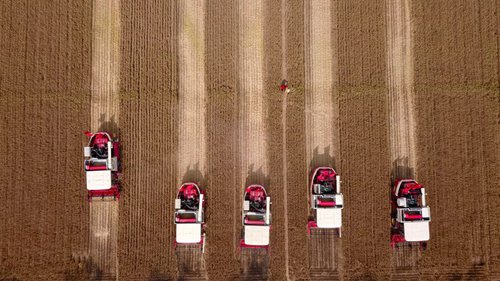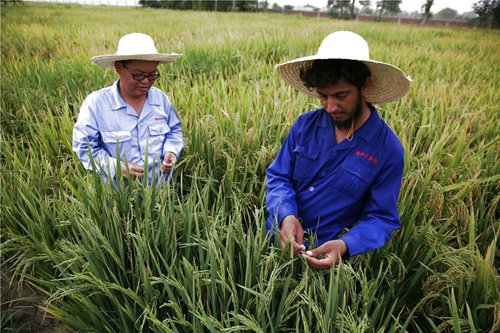China's food self-sufficiency a blessing to world

A farmer harvests rice in a paddy field in Wangtan Town of Tangshan, north China' s Hebei Province, Oct. 14, 2019. About 62,667 hectares of rice in Tangshan has entered harvest season recently. (Xinhua/Yang Shiyao)
What would happen to the world if there were an increase of nearly 1.4 billion hungry mouths to feed?
China is expected to consume 700 billion kg of food in 2020, while the total volume of the global food trade is only about 400 billion kg a year.
If China fails to feed itself properly, the rest of the world will likely suffer.
However, the country has succeeded in feeding 20 percent of the world's population with just 9 percent of the world's farmland and 6 percent of the freshwater. A well-fed China is itself a contribution to world peace and stability.

Aerial photo taken on May 31, 2019 shows reapers harvesting wheat at Zhongshan Township in Jiaxiang County in Jining City, east China's Shandong Province. (Xinhua/Guo Xulei)
Seventy years ago when New China was just founded, Dean Gooderham Acheson, then US secretary of state, asserted that the Chinese government would be unable to feed its 546 million population like its predecessors.
At the first World Food Conference in 1974, representatives and experts from many countries were deeply concerned that "there was no way that China could feed a population of 1 billion."
Food-rationing coupons were issued to balance demand and supply until the late 1970s when the household responsibility system was introduced across the country.
The new system, which allowed farmers to sell their surplus produce in markets after fulfilling their due quotas to the commune, was an instant success that quickly lifted people out of poverty.
In 1973, Chinese agronomist Yuan Longping developed the first hybrid rice strains, which have since been grown across the country allowing farmers to reap bumper harvests.
Between 1949 and 2018, China's annual grain output rose by over five times from 113 million tonnes to 658 million tonnes. A hunger-free China did not impact the world food market, nor did it pose a threat to developing countries' food imports.
China's food production accounts for a quarter of the world's total. The self-sufficiency rates of China's rice, wheat and corn remained above 95 percent, with the per capita output achieving 470 kg, much higher than the global average.

Long Chunjiu (L), chief scientist of Longping South Asia Seed Research and Development Ltd, and research manager Wasim Waheed work at a rice field in Lahore of Punjab province in Pakistan, on July 10, 2019. A project carried out by Guard Agriculture Research and Services in collaboration with Chinese Yuan Longping High Tech Agriculture Company enabled Pakistan to develop the hybrid rice seeds which is the core part in the production. (Xinhua/Jiang Chao)
While food shortages have long been consigned to China's past, the country has set out to save other parts of the world from starvation.
Since the 1980s, Yuan's team has offered training courses in dozens of countries. The total cultivated area of hybrid rice has topped 7 million hectares overseas, yielding over 20 percent more than local rice.
The Food and Agriculture Organization of the United Nations has listed hybrid rice as the best technology to solve food shortages in developing countries.
"Looking to the future, China has the conditions, capabilities and confidence to enhance food security relying on its own efforts," said the white paper "Food Security in China" released Monday.